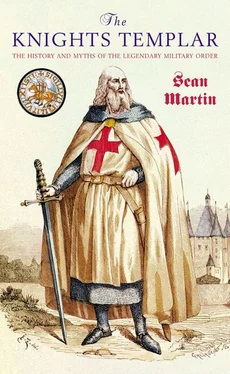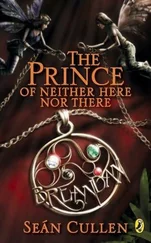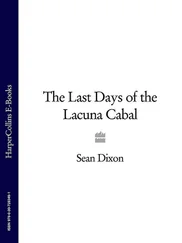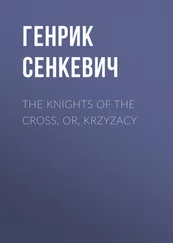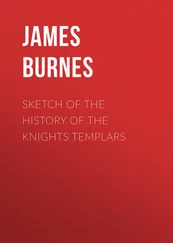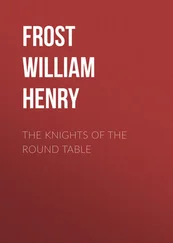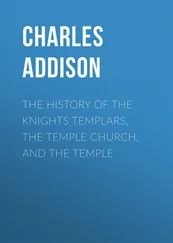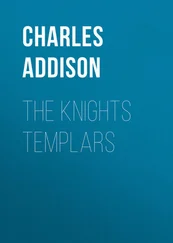Sean Martin - The Knights Templar
Здесь есть возможность читать онлайн «Sean Martin - The Knights Templar» весь текст электронной книги совершенно бесплатно (целиком полную версию без сокращений). В некоторых случаях можно слушать аудио, скачать через торрент в формате fb2 и присутствует краткое содержание. Год выпуска: 2004, ISBN: 2004, Жанр: История, на английском языке. Описание произведения, (предисловие) а так же отзывы посетителей доступны на портале библиотеки ЛибКат.
- Название:The Knights Templar
- Автор:
- Жанр:
- Год:2004
- ISBN:1-904048-28-5
- Рейтинг книги:3 / 5. Голосов: 1
-
Избранное:Добавить в избранное
- Отзывы:
-
Ваша оценка:
- 60
- 1
- 2
- 3
- 4
- 5
The Knights Templar: краткое содержание, описание и аннотация
Предлагаем к чтению аннотацию, описание, краткое содержание или предисловие (зависит от того, что написал сам автор книги «The Knights Templar»). Если вы не нашли необходимую информацию о книге — напишите в комментариях, мы постараемся отыскать её.
The Knights Templar — читать онлайн бесплатно полную книгу (весь текст) целиком
Ниже представлен текст книги, разбитый по страницам. Система сохранения места последней прочитанной страницы, позволяет с удобством читать онлайн бесплатно книгу «The Knights Templar», без необходимости каждый раз заново искать на чём Вы остановились. Поставьте закладку, и сможете в любой момент перейти на страницу, на которой закончили чтение.
Интервал:
Закладка:
The Templars’ first decade is their least documented. After Nablus, we can only assume that they continued to live as monks in the ‘Temple of Solomon’ (the crusaders’ name for the al-Aqsa mosque) and to protect the pilgrims who would arrive by boat at ports such as Jaffa. Despite their poverty and lack of decent armour and weapons, they began to attract supporters from the West. Fulk V, Count of Anjou, met Hugues de Payen on his pilgrimage to Outremer in 1120, and was so impressed with Hugues and his nascent order that he enrolled as an associate of the Templars, pledging to give them an annual income of 30 livres angevines . Inspired by Fulk’s example, several other French nobles did the same, perhaps the most important of them being Hugh, Count of Champagne.
Hugh had first visited Outremer in 1104, where he remained for four years. He returned again in 1114. On one of these occasions, he had been accompanied by Hugues de Payen. Hugues was one of his vassals, Payen being downriver from Troyes, where Hugh had his court. (In fact, Hugues may have even been related to his lord.) By the time Hugues and his eight companions took their vows in the Church of the Holy Sepulchre, Hugh had once again returned to France. He returned to the Holy Land for the last time in 1125, when he finally joined the Templars. But the full significance of Hugh’s relationship to the Templars would have to wait another four years before becoming apparent.
In 1127, with the Templars still – according to the traditional story – only nine knights strong and struggling to recruit new members, King Baldwin II sent Hugues de Payen and several other Templar brethren on a major diplomatic mission to Europe. That Hugues was chosen for such an important job suggests that, contrary to the stories of the Templars being ‘poor knights’, they were in fact by this time quite highly regarded in Outremer. In addition, Hugues took several knights with him, which, if they really were still only nine members strong, would have left only a few brethren back in Outremer. Indeed, chroniclers such as Michael the Syrian (d.1199), who was one of the first to document the Templars, believed that the Order had about 30 serving knights enlisted by the time of Baldwin’s embassy.
The Templar delegation sailed to France, probably in the autumn of 1127, with William of Bures, the Prince of Galile, and Guy of Brisbarre, Lord of Beirut. William and Guy’s mission was to persuade Fulk of Anjou to marry Baldwin’s daughter, Melisende, and thereby stand to inherit the throne of Jerusalem, as Baldwin had no male heir. Whether Hugues’ presence in the delegation was meant to persuade Fulk, who was one of the Templars’ earliest supporters and donors, is not known, but even if it were, Hugues had been charged by Baldwin with another mission: to recruit knights for a projected crusade against Damascus, and to get the Templars officially recognised by the western Church.
The mission was a stunning success: Fulk agreed to return to Outremer and marry Melisende; many new recruits for Baldwin’s Damascene Crusade were signed up; and, perhaps most importantly of all, Hugues met St Bernard of Clairvaux. It is from then on that, with St Bernard’s unwavering support, The Knights Templar emerged from the shadows on to the stage of European history in quite spectacular fashion.
The Council of Troyes
St Bernard of Clairvaux was the most influential Church Father of his time. A Burgundian noble, he was born at Fontaines-les-Dijons in 1090. While he was still in his mother’s womb, a devout had predicted a great future for Bernard, and he seems to have grown into adulthood with a particular fervour and vision. Apparently a charismatic man of quite violent passions, he sought out a religious order whose austerity might help temper his volatile nature, and he entered the Cistercian order at Citeaux in 1113 with 30 or so fellow Burgundian nobles. Three years later, he led a small group of monks to found a new Cistercian house in the nearby valley of Wormwood, which they renamed Clairvaux, Valley of Light. Significantly, the land had been given to them by Hugh of Champagne, around the time of the Count’s second pilgrimage to Outremer. The new foundation at Clairvaux under Bernard quickly became a magnet for the zealous, and the house flourished.
It is not known exactly when Bernard (he became a saint in 1174, a mere 21 years after his death) first became aware of the Templars or met Hugues de Payen. It is probable that King Baldwin wrote to Bernard in 1126 asking him to help devise a Rule for the Order, and to help win for them both recognition and support in the West. Bernard was aware of the situation in the East, and realised that what Outremer needed were knights ready for active military service, not ‘singing and wailing monks’. 5 5 St Bernard, from a letter to Pope Calixtus II, 1124/5. Quoted in Barber, op. cit. , p.13.
Bernard’s keen appreciation of the situation in Latin Syria most probably derived from his friendship with Hugh of Champagne, who had returned to the Holy Land for the third and final time in 1125, when he became a fully fledged Templar, and also from André de Montbard, who was not only one of the original nine knights, but was also Bernard’s uncle. If Hugues and the Templar delegation did indeed sail to Europe during the autumn passage of 1127, then it is possible that Bernard met the Templar Grand Master towards the end of that year, or the following spring before Hugues started his mission proper, which would culminate with the Council of Troyes in January 1129.
As soon as Hugues arrived in Europe, things appeared to start moving very quickly. The Templars received their first grant of land in the West, with a house, a grange, a meadow and a tenement in Provins being given to the Order in October 1127, a gift from Hugh of Champagne’s successor, Theobald, Count of Blois. Theobald also gave his vassals permission to donate freely to the Order from their own holdings of land. The Count of Flanders, William Clito, also donated to the Order around this time, as did his successor, Thierry of Alsace, after William’s death in battle on 27 May 1128. Four days later, Hugues was in Anjou, where he witnessed Fulk take the Cross (a vow to defend Christianity from the infidel). On 17 June, he attended the wedding of Fulk’s eldest son, Geoffrey, to Matilda, daughter of Henry I of England, which then left Fulk free to travel to Jerusalem as Baldwin had hoped. Further grants of land and money were made to Hugues, and it seems likely that the wedding led directly to Hugues being invited to England in the summer of 1128. Hugues’ visit to England resulted in the establishment of the first Templar house, or preceptory, in London, at the north end of what is now Chancery Lane, in addition to gifts of money from the king and the acquisition of several sites outside of the capital. From England, Hugues travelled to Scotland before spending the autumn in Flanders, receiving further donations and preparing for Troyes.
When Hugues de Payen spoke before the Council of Troyes on 13 January 1129, he did so in front of an august assembly of churchmen. Not only was Bernard there in person (despite the fact that he was suffering from a fever), but also Stephen Harding, Abbott of Citeaux, the Archbishops of Sens and Rheims, ten bishops, Count Theobald of Champagne and, according to Jean Michel, the council’s scribe, ‘several others whom it would be tedious to record’. In addition to Hugues, the Templars were represented by Godfrey de St Omer, Geoffrey Bisol, Payen de Montdidier, Roland and Archambaud de St Aignan. 6 6 All of these knights were among the original nine members. According to Barber ( op. cit. , p.12), King Baldwin had already sent two of the original nine Templars, André de Montbard and Gondemar, to France for Church approval of the Order.This would leave only the unknown ninth member (Hugh of Champagne?) in Outremer, reinforcing the theory that the Templars – in order to be taken seriously by Baldwin II, the Pope and the Council of Troyes – had to be more than nine knights strong by 1129.
The whole delegation was presided over by the Papal Legate, Matthew of Albano.
Интервал:
Закладка:
Похожие книги на «The Knights Templar»
Представляем Вашему вниманию похожие книги на «The Knights Templar» списком для выбора. Мы отобрали схожую по названию и смыслу литературу в надежде предоставить читателям больше вариантов отыскать новые, интересные, ещё непрочитанные произведения.
Обсуждение, отзывы о книге «The Knights Templar» и просто собственные мнения читателей. Оставьте ваши комментарии, напишите, что Вы думаете о произведении, его смысле или главных героях. Укажите что конкретно понравилось, а что нет, и почему Вы так считаете.
